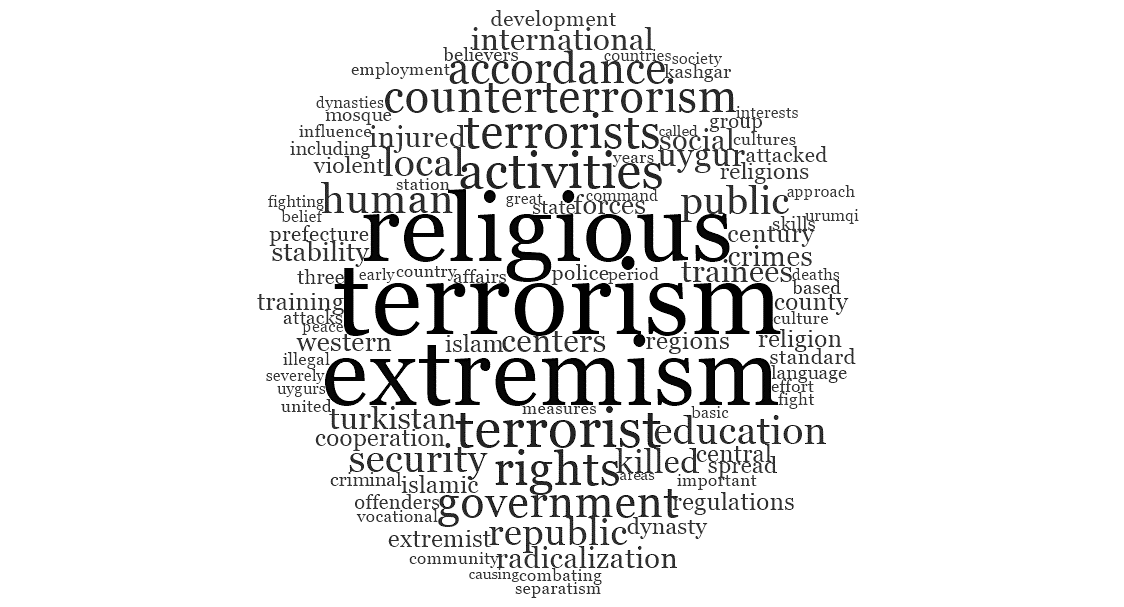Original document link: Click Here
Overview
The paper starts by setting the theme, highlighting terrorism as a threat and attempts to pre-empt any notion of Xinjiang’s sovereignty by giving a short overview of the Chinese claim over Xinjiang. In the first two sections, the paper seeks to show the close linkage between separatism and extremism in Xinjiang and gives a short overview of the East Turkestan separatist movement and accuses it of continued acts of sabotage. It makes a distinction between Islam and religious extremism but accuses extremists of creating a division between believers and non-believers. The third section of the paper lists out ‘attacks’ purportedly carried out by terrorists and separatists.
In the fourth section, the importance of fighting terrorism while sticking to the principles of law is highlighted. The local regulations that have been enacted for this purpose include The Regulations of Xinjiang Uyghur Autonomous Region on Religious Affairs, the Measures of Xinjiang Uyghur Autonomous Region on Implementing the Counterterrorism Law of the People’s Republic of China, and the Regulations of Xinjiang Uyghur Autonomous Region on De-radicalization. The paper highlights the promulgation of the Regulations of Xinjiang Uyghur Autonomous Region on Religious Affairs as a means of protecting ‘lawful religious activities.’The section on preventive counterterrorism highlights the establishment of ‘education and training centres’. ‘Trainees’ at these centres are divided into three categories:
- People who were incited, coerced or induced into participating in terrorist or extremist activities, or people who participated in terrorist or extremist activities in circumstances that were not serious enough to constitute a crime;
- People who were incited, coerced or induced into participating in terrorist or extremist activities, or people who participated in terrorist or extremist activities that posed a real danger but did not cause actual harm, whose subjective culpability was not deep, who made confessions of their crimes and were contrite about their past actions and thus can be exempted from punishment in accordance with the law, and who have demonstrated the willingness to receive training;
- People who were convicted and received a prison sentence for terrorist or extremist crimes and after serving their sentences have been assessed as still posing potential threats to society, and who have been ordered by people’s courts to receive education at the centres in accordance with the law.
According to the document, the individuals falling in these three categories are to be placed in these ‘education’ centers, while individuals in the second category might also receive severe punishment in accordance with Articles 29 and 30 of the Counterterrorism Law of the People’s Republic of China.
The paper also gives an overview of the centers’ curriculum and its rationale. It consists of standard spoken and written Chinese language, law, vocational skills, and courses on the eradication of extremism.
The paper cites a lack of violent or terrorist activities over the past two years as proof of the program’s success. It clarifies that no specific region, ethnic group or religion is a target of these laws. In the next section while highlighting the ‘most notorious terrorist attacks’, the paper lists 13 attacks whose perpetrators were all associated with militant Islamic fundamentalist groups. It also highlights close collaboration with neighbouring countries in fighting terrorism. The paper concludes by carefully highlighting (as it also does throughout the text) that all its anti-terrorism efforts have been in accordance with the law.
| 15 most common words: | |
|---|---|
| Word | Count |
| terrorism | 74 |
| extremism | 67 |
| religious | 67 |
| terrorist | 37 |
| activities | 34 |
| rights | 32 |
| terrorists | 31 |
| counterterrorism | 30 |
| government | 29 |
| accordance | 28 |
| human | 27 |
| education | 25 |
| local | 25 |
| public | 25 |
| security | 25 |
Word cloud:
(Minimum 5 letters)
